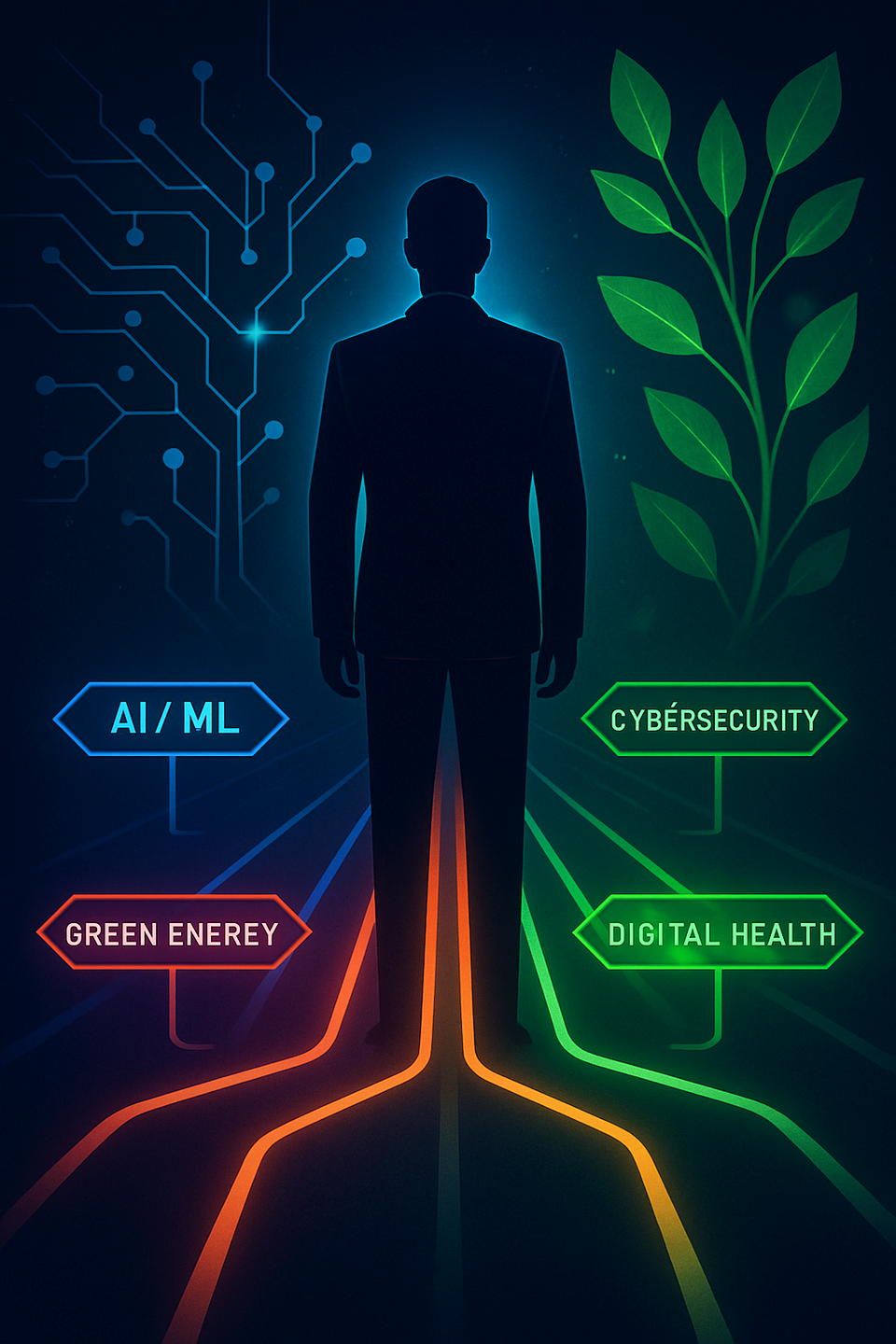3 Career Pivoting Areas for Technical Program Managers to Weather the Emerging AI Storm

I thought I’d share my personal thoughts, anecdotes, and observations as a Technical Program Manager for over ten years, as I have worked for numerous large corporations like Amazon and Walmart, and startups, and how I see this emerging black cloud of AI coming in and sucking up headcount hiring.
Firstly I do want to say off-the-bat, it is hard to say where our jobs as TPMs will be five or ten years from now, but we are certainly living in very volatile times. But one thing I can say, as TPM’s we are accustomed to working with ambiguity in our programs and so why not manage your career in the same way?
The World Economic Forum’s Future of Jobs Report 2025 highlights that 170 million new jobs could be created this decade, while 92 million roles may be displaced1. Employers expect 39 % of key skills required in the labour market to change by 2030, and green transitions and technological adoption (artificial intelligence, big data, cloud computing, renewable energy, etc.) are among the top forces reshaping work . Studies from Forbes and McKinsey suggest that between 30 % and 50 % of US jobs could be automated by 2030 . On the other hand, roles emphasizing creativity, complex problem‑solving and human interaction—such as project management, AI governance and healthcare—are more resilient . This report summarizes emerging careers and up‑skilling paths that can hedge a TPM’s long‑term prospects.
So as a TPM, what can you do to pivot, adjust to the emerging climate and environment? I have a few areas you could pivot to and even if things don’t change as drastically, skills and areas worth investing in. In order words, low risk/high reward.
1. AI and Data‑Driven Product Management
So AI and Machine Learning (ML) are touching on every environment, and GenAI has certainly been the catalyst. Product Manager productivity has increased by 40% thanks to GenAI and those who fail to adopt AI risk being replaced2.
Eleken’s 2025 guide states that there were over 14 000 AI‑product‑manager openings globally in late 2023 (nearly 6 900 in the US), and the average U.S. salary was ≈$133 600, rising to $200 000 for senior roles. The role demands understanding model lifecycles, data ethics and user‑centric design.
How to prepare
- Strengthen AI fluency: Learn Python and basic ML frameworks (e.g., TensorFlow or AWS SageMaker) and study AI ethics. Product managers should understand how models are trained, tested and deployed;
- Gain Experience with data-driven decision making: Acquire data‑science skills such as SQL, data visualization and A/B testing. These are widely demanded skills as companies seek insights from large datasets;
- Ethical and Responsible AI: The Hiring Lab found that mentions of “Responsible AI” in job postings rose from almost zero in 2019 to 0.9 % of AI postings in 2025 , reflecting growing demand for AI ethics specialists. Understanding bias, privacy and regulatory frameworks (e.g., EU AI Act) can differentiate you.
- Certifications: Consider AI project‑management certificates (e.g., PMI’s CPMAI, AI‑Driven Project Manager certification) or data‑science certificates (Google’s Data Analytics). AI PM certification programs are recommended for integrating AI into project workflows.
The bridge to product management from program management isn’t too far, yet it could be a rewarding fork.
2. Cybersecurity Leadership and Risk Management
Another huge area and will continue to be, is cybersecurity. With digital adoption and especially GenAI adoption comes increased cyber risk. The U.S. Bureau of Labor Statistics (BLS) projects employment of information security analysts to grow 29 % between 2024‑20343, creating 52 100 new jobs. Cybersecurity roles offer high median pay ($124 910 in May 2024) . Robert Half’s 2025 tech hiring report notes that cybersecurity analysts and network security engineers are among the top 15 % of in‑demand tech roles  and that unemployment rates for security analysts are extremely low (2.3 % versus a national average of 4.2 %)4.
Pivoting to this role, you will need to invest in:
- Leverage program-management skills: You already manage cross-functional teams, budgets and schedules—skills valued in cybersecurity project management (e.g., implementing security programs, incident-response planning). The Institute of Data notes that project‑management, communication and risk‑analysis backgrounds transfer well to cybersecurity5;
- Gain technical expertise: Acquire certifications like CompTIA Security+, Certified Ethical Hacker (CEH), or Certified Information Security Manager (CISM). Vault’s guide for career changers emphasizes that even non‑technical professionals can enter cybersecurity through certifications and training6;
- Understand compliance and governance: Experience with SOC 2 audits, NIST standards or GDPR/California Consumer Privacy Act will be valuable for leadership roles;
- Upskill in cloud and DevSecOps: Many organizations are shifting to cloud infrastructures; knowledge of AWS/Azure security services and DevSecOps practices is critical.
3. Data Science and Analytics
One of the fastest growing and highest paid fields is Data Science. The BLS7 projects 34 % growth in data scientist employment through 2034, with median pay around $112 590 . Robert Half lists data analysts and data engineers among the most in‑demand roles . Demand spans industries, from finance and healthcare to retail and manufacturing8.
Preparing to transition to this domain, you should focus on:
- Foundational skills: Build expertise in statistics, machine‑learning algorithms, and programming languages like Python or R. Understanding data cleaning, feature engineering and model evaluation is essential;
- Upskill through part‑time courses: Bootcamps such as DataCamp, Coursera’s Professional Data Science Certificate, or Udacity’s Machine Learning Engineer program provide flexible training. Because the field is technical, hands‑on projects and Kaggle competitions can accelerate learning;
- Develop storytelling: Many TPMs are adept at communicating with executives. Data scientists must translate technical insights into actionable business decisions;
- Consider domain specialization: Combine data skills with domain knowledge (supply chain, finance, healthcare) for niche roles such as data product manager or AI‑enabled operations director.
4. Combining TPM Expertise with Entrepreneurship or Consulting
I thought I’d throw this one in in case you want to stick to your area or domain but augment your trajectory slightly. Like me, 10 years as a TPM, 20 years in engineering, I could pivot into independent consulting or starting my own venture. The WEF report9 notes that developing green technologies and climate solutions offers entrepreneurial opportunities, particularly where established industries face adaptation challenges . Similarly, AI and cybersecurity have broad cross‑industry demand, creating niches for boutique consultancies.
You can pivot into consulting by:
- Leveraging your network: Use your industry contacts from current and past employers, and previous programs to identify client needs.
- Build thought leadership: Start a podcast or blog focusing on AI governance or sustainability to attract clients.
- Acquire business skills: Study entrepreneurship (e.g., Y Combinator’s startup school), lean startup methodologies and small‑business finance.
Final Thoughts
There is no doubt that Artificial intelligence and automation will reshape work, but opportunities are abound for professionals who adapt. Technical Program Managers have a valuable foundation, technical literacy, cross‑functional leadership and strategic planning, that can be leveraged into multiple high‑growth fields. To hedge your career for the next 20 years, invest in AI fluency, cybersecurity, data science, sustainability, healthcare technology and business transformation. Pair these skills with certifications and continuous learning, and remain curious about emerging technologies like VR/AR, blockchain and quantum computing. By blending your experience with new technical and green skills, you’ll position yourself as a versatile leader capable of thriving amid uncertainty.
But don’t leave it to the last minute, even if you are happy where you are at, bootstrap your knowledge into other areas as they will serve you in your current role or yet-to-be-defined future role.
- https://www.weforum.org/stories/2025/01/future-of-jobs-report-2025-jobs-of-the-future-and-the-skills-you-need-to-get-them/#:~:text=,likely%20need%20in%20the%20future ↩︎
- https://productschool.com/blog/artificial-intelligence/guide-ai-product-manager#:~:text=According%20to%20McKinsey%20,%E2%80%8C%EF%BB%BF%E2%80%8D%EF%BB%BF%E2%80%8D%E2%80%8D%E2%80%8C%E2%80%8D%EF%BB%BF%EF%BB%BF%E2%80%8C%EF%BB%BF%E2%80%8D%E2%80%8C%E2%80%8D%E2%80%8D%E2%80%8C%E2%80%8C%E2%80%8D%E2%80%8C%EF%BB%BF%E2%80%8C%E2%80%8D%E2%80%8D%E2%80%8C%E2%80%8C%E2%80%8D%EF%BB%BF%E2%80%8D%E2%80%8D%E2%80%8D ↩︎
- https://www.bls.gov/ooh/computer-and-information-technology/information-security-analysts.htm#:~:text=Video%20transcript%20available%20at%20https%3A%2F%2Fwww,Employment%20Change%2C%202024%E2%80%9334%2052%2C100 ↩︎
- https://www.roberthalf.com/us/en/insights/research/data-reveals-which-technology-roles-are-in-highest-demand#:~:text=What%20technology%20roles%20are%20in,demand ↩︎
- https://www.institutedata.com/us/blog/tech-careers-in-2025/#:~:text=Why%20Choose%20a%20Career%20in,Cybersecurity ↩︎
- https://vault.com/blogs/innovate-with-influence-global-high-tech/top-tech-roles-for-career-changers-in-2025#:~:text=Cybersecurity ↩︎
- https://www.bls.gov/ooh/math/data-scientists.htm#:~:text=https%3A%2F%2Fwww,Employment%20Change%2C%202024%E2%80%9334%2082%2C500 ↩︎
- https://www.institutedata.com/us/blog/tech-careers-in-2025/#:~:text=Industries%20That%20Rely%20on%20Data,Science%20and%20AI ↩︎
- https://globis.training/the-future-of-jobs-and-the-green-talent-gap/#:~:text=The%20green%20transition%20creates%20structural,technologies%20to%20transform%20their%20operations ↩︎

Member discussion